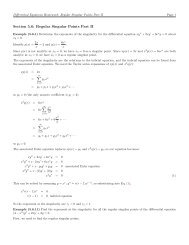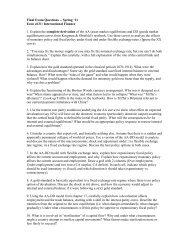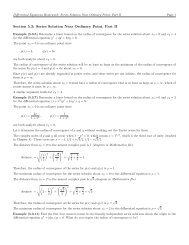Designing Efficient Snow Plow Routes - University of Minnesota
Designing Efficient Snow Plow Routes - University of Minnesota
Designing Efficient Snow Plow Routes - University of Minnesota
You also want an ePaper? Increase the reach of your titles
YUMPU automatically turns print PDFs into web optimized ePapers that Google loves.
we divided the students randomly into three groups, each <strong>of</strong> which were randomly assigned<br />
projects within the categories mentioned above. For instance, we assigned the project described<br />
in Section 2 on designing efficient snow plow routes to a team <strong>of</strong> four students.<br />
A course project is mandatory when we teach this course, and the project carries the same<br />
weight as one <strong>of</strong> the three within-term exams. The requirement <strong>of</strong> the course project is for<br />
students to discuss and analyze an application <strong>of</strong> a topic covered in the course; they may have to<br />
look ahead in the syllabus to browse the topics. Students usually work on these projects in pairs;<br />
each group is required to submit a written report and give an in-class 20-minute oral presentation<br />
at the end <strong>of</strong> the term. When we incorporated service-learning, we chose to do projects that were<br />
<strong>of</strong> value to the community in which we were a part.<br />
As the Course Progressed<br />
Each student group met regularly outside <strong>of</strong> class time to work on their project over the course <strong>of</strong><br />
the entire term. It is advisable to have a group leader whose main job is to coordinate these<br />
meetings and keep a central working document <strong>of</strong> the written report.<br />
The value <strong>of</strong> communication among all parties involved, i.e., the students, the instructor,<br />
the service-learning coordinator, and the community agencies, should not be underestimated. We<br />
(instructor and student groups) met on a weekly basis outside <strong>of</strong> class time and by appointment<br />
to discuss issues <strong>of</strong>, and progress on, the projects; the length <strong>of</strong> the meeting was very short at the<br />
beginning <strong>of</strong> the term and was much longer (about an hour) towards the end <strong>of</strong> the term. The<br />
instructor was a facilitator in making sure that timely progress occurred and that the analyses<br />
done and reports written were mathematically correct.<br />
The coordinator <strong>of</strong> our SEAMS Grant was the liaison between the community agencies<br />
and the class (students and instructor). We cannot put enough emphasis on how important it is to<br />
have a liaison who is familiar with the people within the community as well as the instructor and<br />
students, and who has some knowledge <strong>of</strong> the contents <strong>of</strong> the course. Whenever we had specific<br />
questions on a piece <strong>of</strong> data or information from the agencies, the coordinator came back with<br />
responses within a couple <strong>of</strong> days or amicably pressured the community agencies for prompt<br />
responses. This is in addition to several short meetings that the coordinator set up during the first<br />
third <strong>of</strong> the course. There was an instance during the term when students felt that a face-to-face<br />
discussion on several small issues that arose in the middle <strong>of</strong> their project was necessary with a<br />
particular agency. The coordinator contacted the people <strong>of</strong> that agency and immediately<br />
scheduled a short visit to class within a few days.<br />
At the End <strong>of</strong> the Term<br />
Within their groups <strong>of</strong> about 4 persons each, the students did all the analyses on their own, with<br />
their instructor as an advisor and expert to bounce technical questions <strong>of</strong>f. Also, they wrote their<br />
final reports and gave oral presentations to which people from Campus Compact and the<br />
community agencies were invited. Again, their instructor advised the students on the<br />
organization <strong>of</strong> their written reports and gave feedback on their trial presentations.<br />
In terms <strong>of</strong> evaluations, a university-required course evaluation and a post servicelearning<br />
evaluation from Campus Compact were given to the students at the end <strong>of</strong> the term. The<br />
only written "reflection process" on the students' part came from what they said in these<br />
evaluations.<br />
As for grading the project, which carries about 15% <strong>of</strong> the course grade, half <strong>of</strong> the<br />
project grade is on the final report and the other half on the in-class oral presentation. The













